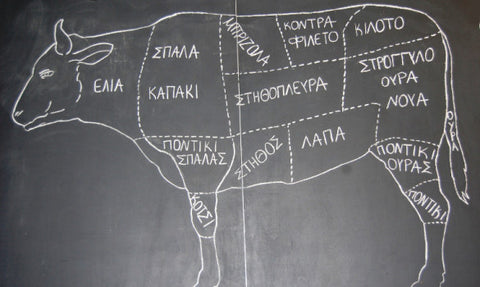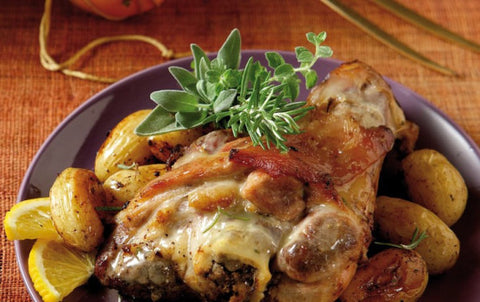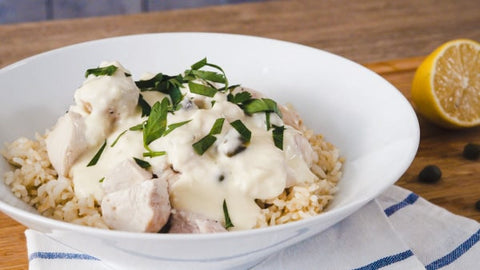Beef is divided into some basic cuts which serve to cut the meat initially. Usually the calf is cut in half lengthwise and then each side is divided into forequarters and hindquarters. After that come the "second" or even "third" cuts which determine retail sales and serving in fine dining restaurants. The most specialized cuts come from two schools, the American and the French. Gradually, some of the specialized ones were also adopted in Greece, especially in restaurants and less so in everyday households.
The main cuts of beef in Greece:
Olive
The Olive is located at the front point of the calf and extends to the front of the leg muscles, it belongs to an area called the Front Chuck in English and usually includes the neck. It contains connective tissue (including fat and collagen) that melts during cooking and is extremely tender. This meat is ideal for stewing, slow cooking, skewering or pot roasting because the point, especially near the bone, gives very tender meat. The tougher pieces near the outer surface are usually also minced to be used for hamburgers, meatballs, etc. and is one of the most affordable pieces available
Sirloin steak with or without the bone
This is the "epic" steak that leads meat eaters everywhere to crave the time when they will be delivered to the first bite. It originates from the upper part of the back of the calf, after the neck, includes the first 5 ribs, and is usually of very large dimensions. Sirloin steak (or sirloin steak as it is also called) contains intramuscular fat, which allows it to melt when cooked and gives a soft, juicy and delicious taste with the characteristic "marbling" effect.
Steaks
Following the point of the back from which we take the flank steaks, the steaks are cut from the 6th to the 12th vertebra of the calf. No recommendations are needed for this particular spot, they are an easy to handle spot of beef that is excellent both on the grill and in the pan or oven usually on the bone or without.
Lid
The cap comes from the inside of the shoulder. They are close to the rib steaks, so you may often see them sold together. It is very tender, and when not included in steaks, it is sold as suitable for mincing and cooking in the pot.
Beef Fillet
The softest, finest and most precious part of the calf. We take the veal tenderloin from a muscle on the back of the calf, below the ribs, on the inside of the lumbar spine. This particular muscle does not move much and does not contribute to the weight load of the calf, therefore its connective tissues do not harden. We recommend it ideally because it is the most manageable piece in the kitchen.
Panties
The pantyhose is located on the last vertebra of the calf, high up on the spine and at the back, in the pelvis of the calf. As a piece, it contains enough collagen, so it is suitable for both stews and soups or broths, roast beef, roast.
Spala
The shoulder is located below the neck, on the shoulder of the calf, and is one of the cuts of meat that has the least fat. It is one of the finest cuts of veal, but the tenderness that characterizes all its cuts makes the price an insignificant factor. It consists of the scallop, the noua and the shoulder mice.
The veal scallop, found in the shoulder, is considered the finest of all cuts, due to the concentration of collagen, which makes it soft with a "melt in the mouth" texture. Because there is a small amount per animal, it is usually a little more expensive than the rest of the pieces. The scallop is suitable for stewed in the pot, braised, lemonade or in a yuvetsaki, it "honeys" uniquely and accompanies wonderful pasta.
The shoulder noir (royal fillet or spalomita) and the shoulder mice are also lean cuts, which are cooked to perfection in the pot.
Against
The sirloin or sirloin is found together with the tenderloin on the back of the calf near the back and before the breeches. It is divided into various cuts and can be sold either boned or boneless. It yields as fine a meat as the tenderloin, and many steaks are cut from it.
Noah
Noir is a lean cut of veal leg and a suitable cut of meat for casserole as it is a bit tougher. It can be thinly sliced after cooking and as it is a somewhat drier meat it is excellent with some sauce.
Trans
The tranny is located on the inner thigh between the panties and the tail. It is a very good choice for schnitzels, roasted in the oven but cooks just as well in the pot.
Round
The round of the calf starts at the panty and extends to the knee of the calf. Excellent choice, tender piece of meat. It is located right under the panties and because it gathers high percentages of collagen it is a suitable choice for stews. The collagen helps bind the sauce whether you make it red or lemonade.
Rat-Mouse
The mouse and the shank are found on the lower ends of the animal's leg near the locks, and the rule says that you must taste them in soups or boiled. And at this point there is a high concentration of collagen, while they have enough moisture. In soups and broths they are food rich in nutrients and are also recommended for children.
Lapa
The loin is one of the fattiest parts of the veal, along with the breast. This meat is considered lower quality and therefore cheaper than other places due to the fat. Basically, lapa is the area of the belly of the calf, it is located in the middle and next to the shoulder and is especially used in minced meat. If it is not cut for mince, it can also be made into a roll as the meat is really very soft.
Ribs & Chest
The ribs are made up of many bones and connective tissues. They are also called "railway" and in large pieces are suitable for grilling. They are not very cold but they are very fatty and therefore they are a very good choice for boiling as well.
Now that you know the basic cuts of beef you can experiment with many different recipes depending on whether you prefer lean cuts of beef (such as tenderloin, round or sirloin), moderately fatty (such as shoulder, loin and loin ), or very fatty cuts (such as breast or loin).




Comments (0)
There are no comments for this article. Be the first one to leave a message!